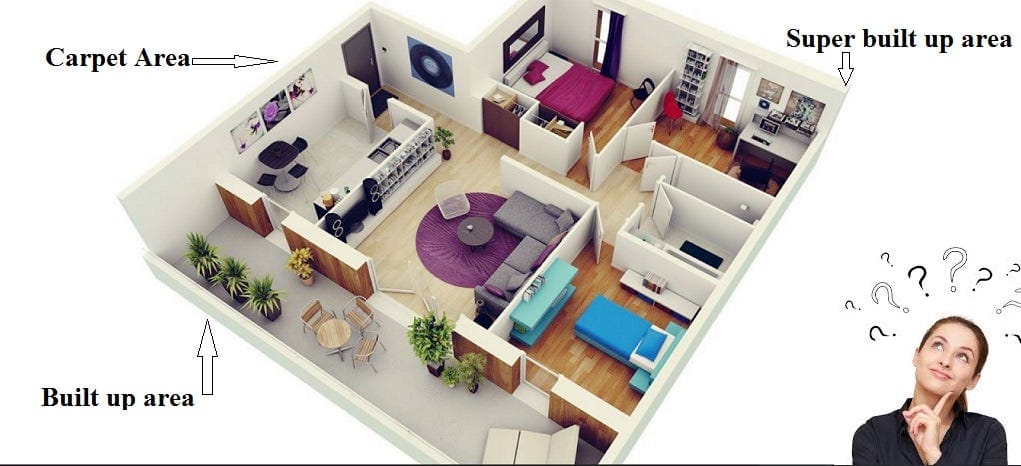When buying a home, understanding the nuances of real estate terminology can be crucial to making an informed decision. The most important terms to comprehend are Carpet Area, Built-up Area, and Super Built-up Area. These terms are used to define the space within a property, but each measures different aspects of the property, affecting not only the price but also the utility and value of the space. Here’s a detailed look at what each of these terms means and why they matter.
What is a Carpet Area?
Carpet Area refers to the actual usable area within the walls of an apartment or house where you can lay a carpet. Essentially, it is the net usable floor area of the unit. This excludes the thickness of the inner walls but includes all rooms such as bedrooms, living rooms, kitchens, bathrooms, and internal staircases if any.
According to the Real Estate (Regulation and Development) Act (RERA) of 2016, the Carpet Area is defined as “the net usable floor area of an apartment, excluding the area covered by the external walls, areas under services shafts, exclusive balcony or verandah area, and exclusive open terrace area, but includes the area covered by the internal partition walls of the apartment.”
Understanding the Carpet Area is vital because it directly affects the usability of your home. When planning the layout of your furniture or considering the practicality of your living space, the Carpet Area provides the most accurate measurement.
What is a Built-up Area?
The Built-up Area includes the Carpet Area plus the area occupied by the apartment’s walls. This means it covers the thickness of the inner and outer walls, as well as any balconies and terraces that are exclusive to the unit.
To calculate the Built-up Area
Built-up Area = Carpet Area + Area of walls + Balcony/terrace area
The Built-up Area gives a more comprehensive measurement of the space you own but can use partially. While it includes spaces that might not be usable for living purposes (like the thickness of walls), it’s an important metric for understanding the total scope of your property.
What is a Super Built-up Area?
Super Built-up Area, often referred to as the saleable area, includes the Built-up Area plus a proportionate share of the common areas in the building. Common areas include lobbies, staircases, elevators, corridors, and amenities such as the clubhouse, garden, and swimming pool.
To calculate the Super Built-up Area:
Super Built-up Area=Built up Area+Proportionate share of common areas
Developers often use the Super Built-up Area: to quote the price of the property, which can sometimes be misleading. While the Super Built-up Area includes spaces that enhance the living experience, they are not part of the individual unit’s usable space.
Why Understanding These Terms is Important
Cost Implications: Knowing the differences between these areas can help you understand what you’re paying for. Developers typically price properties based on the Super Built-up Area, but it’s the Carpet Area that dictates how much usable space you get. A larger Super Built-up Area might include more common spaces, which can inflate the cost without adding to your usable living space.
Utility and Space Planning: For practical purposes, Carpet Area is the most relevant metric when considering how to use the space in your home. Understanding Built-up and Super Built-up Areas is useful for knowing the total scope of the property and the shared amenities that come with it.
Legal and Transparency Aspects: RERA mandates that developers provide clear information about the Carpet Area, which promotes transparency and helps buyers make more informed decisions. It’s essential to ensure that the Carpet Area is mentioned in the property agreement to avoid any discrepancies later.
Resale Value: When you decide to sell your property, potential buyers will consider the Carpet Area more closely since it represents the actual living space. A clear understanding of these measurements can aid in negotiating better resale values.
Practical Tips for Homebuyers
Always Verify: Request detailed plans and verify the Carpet Area as per RERA guidelines. Don’t just rely on the Super Built-up Area for your decision-making.
Compare Properties: When comparing different properties, use the Carpet Area to understand the actual usable space each property offers.
Understand the Ratio: Be aware of the ratio between the Carpet Area, Built-up Area, and Super Built-up Area. A higher proportion of Super Built-up Area might mean less usable space.
Seek Clarification: Don’t hesitate to ask developers to explain the proportionate share of common areas included in the Super Built-up Area.
Understanding the distinctions between Carpet Area, Built-up Area, and Super Built-up Area is crucial for anyone looking to buy property. These measurements affect the usability, cost, and overall value of your home. By grasping these concepts, you can make more informed decisions, ensuring that you get the best value for your investment and a home that meets your needs. Remember, transparency and clarity are your best allies in the real estate market.
